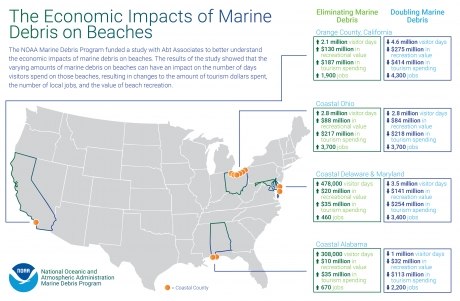The Economic Impacts of Marine Debris on Tourism-Dependent Communities
Posted
Last Updated
The tourism and recreation sector is the largest employer in the ocean and Great Lakes economy. This sector relies heavily on healthy coastal and ocean resources as well as the aesthetic quality of the environment. Unfortunately, marine debris is a pervasive issue in many coastal areas of the United States, where tourism and recreation account for $124 billion in gross domestic product (GDP).
To better understand the relationship between coastal tourism economies and marine debris, the NOAA Marine Debris Program funded a study to look at how the amount of marine debris on beaches can affect the behaviors of beachgoers and as a result, the economies of coastal communities that depend on tourism. Most notably this study reveals that doubling the amount of marine debris on beaches within these coastal areas would decrease the number of days visitors spend on those beaches. This decline in beach visitor days would result in fewer tourism dollars spent, and translate into a decrease in local jobs.
This study evaluated two types of economic impacts that result from the effects of doubling and the near elimination of marine debris on beach recreation: the loss or gain of recreational value to beach visitors, and the economic impact from reduced or increased spending on beach visits in four selected coastal areas across the contiguous United States. The study areas were the Gulf of Mexico beaches in Alabama, Atlantic Ocean beaches in Delaware and Maryland, Lake Erie beaches in Ohio, and Pacific Ocean beaches in Orange County, California.
Recreational value and impacts from changes in marine debris amounts
To understand the relationship between marine debris and recreational beach use, the study recruited participants at beaches in the four selected coastal areas and asked them questions about their beach recreation, their opinions about marine debris, and how their beach visits would change if there were varying amounts of debris on beaches. The data was used to understand how an increase or decrease in the amount of marine debris on the beach would affect the number of beach visits in each area.

